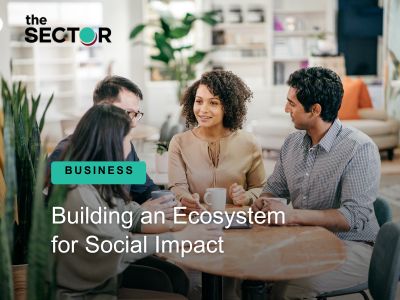Building an Ecosystem for Social Impact
In today’s world, social enterprises play a crucial role in addressing societal challenges and driving positive change. However, the success of these organizations heavily relies on their ability to build strong ecosystems. By establishing strategic partnerships and effective communication channels, social enterprises can amplify their impact and create lasting change.
Defining Roles and Communication Modes

To ensure smooth collaboration within the ecosystem, it is essential to define clear roles and establish effective communication modes. This helps to avoid confusion, streamline decision-making processes, and maximize the efficiency of the ecosystem. But how can social enterprises determine the right roles and communication modes?
Lessons learned from real-life case examples provide valuable insights. For instance, let’s consider a social enterprise that successfully built an ecosystem in a specific context. They started by conducting an analysis of their ecosystem’s needs and identifying key stakeholders. By involving these stakeholders in defining their roles and selecting appropriate communication modes. They were able to foster a sense of ownership and collaboration among all participants.
It is important to note that every ecosystem is unique. And the roles and communication modes may vary. Hence, social enterprises should adapt these lessons to their specific context. Ensuring that all stakeholders are engaged and empowered to contribute effectively.
Proposed CRM Database Structure

Managing partnerships and relationships is a critical aspect of ecosystem building. To streamline this process, social enterprises can leverage Customer Relationship Management (CRM) databases. These databases provide a structured approach to organize and track interactions with various stakeholders.
When establishing a CRM database, consider incorporating key fields that capture relevant information. These fields may include contact details, stakeholder type, organization name, area of focus, email, phone number, website, and an assessment of priority for each partner. By adding these fields, social enterprises can easily manage their relationships and make sure that the appropriate stakeholders are involved when needed.
It is worth mentioning that while the proposed CRM database structure provides a starting point. It should be tailored to each social enterprise’s specific needs. The database should align with the organization’s goals and objectives, capturing information that is relevant to its ecosystem building efforts.
Conducting Market Research and Identifying Partners for the Ecosystem

Expanding into new jurisdictions requires a deep understanding of the local landscape. Market research plays a pivotal role in identifying potential partners and assessing the viability of the social enterprise’s mission in a specific region.
During the market research process, social enterprises should explore various avenues to gather information. This may include conducting surveys, interviews, and focus groups with key stakeholders. By engaging directly with the community and other relevant organizations, social enterprises can gain insights into the local challenges and opportunities.
Based on the market research findings, social enterprises can identify potential partners who align with their goals and share a common vision. These partners can include service delivery organizations, trade unions, charities, and other stakeholders with similar mandates. Working together with these partners can make the social enterprise’s impact better and create a more complete solution to solve the challenges that have been identified.
System Alignment and Ecosystem Collaboration

Building a successful ecosystem requires alignment with other system-wide priorities and collaboration with relevant organizations. Social enterprises should connect with system alignment partners and employment support organizations that focus on broader societal goals such as skills development, economic development, affordable housing, poverty reduction, criminal reform, and infrastructure development.
By aligning with these partners, social enterprises can leverage shared resources, knowledge, and expertise. This collaboration enables them to address complex challenges holistically and create sustainable solutions. Additionally, by working together, social enterprises and their partners can amplify their collective impact and drive systemic change.
To foster collaboration, social enterprises should explore different partnership models that align with their ecosystem’s objectives. These models can range from informal collaborations to more structured alliances. The choice of partnership model depends on the specific context and the goals of the social enterprise. By selecting the most suitable model, social enterprises can ensure effective collaboration and maximize the potential for positive impact.
Networking and Collaboration Opportunities for Social Impact
Networking plays a crucial role in ecosystem building. It provides social enterprises with opportunities to share their successes, learn from others, and explore potential collaborations. By actively participating in networking events social enterprises can expand their reach and connect with like-minded organizations.
During networking events, social enterprises can showcase their achievements and engage in meaningful conversations with potential collaborators. By showcasing their impact, social enterprises can attract funding, gain support from influential individuals, and strengthen their position within the ecosystem.
Collaboration opportunities often arise during networking events. By actively seeking out partnerships and exploring shared projects, social enterprises can expand their impact and create synergistic solutions. Collaborative projects can range from joint initiatives to co-designing programs and advocating for systemic changes. These collaborations enable social enterprises to leverage collective expertise and resources, further enhancing their ability to drive social impact.
Establishing Agreements and Monitoring Social Impact

Once partnerships are formed, it is vital to establish clear agreements and monitor the impact of collaborative efforts. Establishing contractual agreements helps to define the responsibilities, expectations, and scope of work for each partner. It ensures that all parties are aligned and committed to the shared goals.
Monitoring impact is essential to track the progress and effectiveness of the collaborative initiatives. Social enterprises should establish key performance indicators (KPIs) to measure the outcomes and impact of their programs. By regularly evaluating these KPIs, social enterprises can identify areas for improvement, celebrate successes, and make data-driven decisions to optimize their impact.
Additionally, it is important to reassess the sustainability of collaborative projects. Social enterprises should continuously evaluate the scalability and long-term viability of their initiatives. This assessment helps to ensure that the collaborative efforts remain relevant, impactful, and sustainable over time.
The Bottom Line
Building an ecosystem for social impact is a complex and dynamic process. It requires social enterprises to actively engage with stakeholders, establish partnerships, and foster collaboration. By following the strategies outlined in this blog post, social enterprises can navigate the ecosystem building journey and create lasting impact in their communities.

